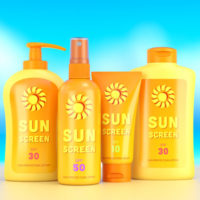FDA Worried About What Is In Sunscreen
August 15, 2019 Recently, the Food and Drug Administration (FDA) said that only two of 16 active ingredients most commonly used in sunscreens are “generally recognized as safe and effective.” The agency is raising concerns over the chemicals, saying they can enter the bloodstream at levels far higher than the FDA’s safety threshold. With such little data available on the affects of absorbing the chemicals into the bloodstream, the FDA says there is a critical need for further examining potential toxicity levels.
Recently, the Food and Drug Administration (FDA) said that only two of 16 active ingredients most commonly used in sunscreens are “generally recognized as safe and effective.” The agency is raising concerns over the chemicals, saying they can enter the bloodstream at levels far higher than the FDA’s safety threshold. With such little data available on the affects of absorbing the chemicals into the bloodstream, the FDA says there is a critical need for further examining potential toxicity levels.
Sunscreen products were put on the national market before many of the FDA’s standards and regulations were even in place. Now, commercial sunscreens have to catch up to modern day rules. It is important to know that the FDA is not saying to stop using sunscreens. Sunscreens are one of the most effective ways to prevent skin cancer and other dangerous and deadly types of sun damage. Instead, the agency is saying that sunscreen makers and product safety agencies must come together to ensure they are doing their best to protect consumers.
The FDA’s Findings on Chemicals in Sunscreens
The two active ingredients commonly used in sunscreens that the FDA has called “generally safe and effective” are used in mineral, not traditional, sunscreens. The chemicals are zinc oxide and titanium dioxide. The main difference between mineral and traditional sunscreens is that mineral sunscreens use physical blockers, like zinc oxide, to guard against sunrays. Traditional sunscreens employ other chemicals to absorb – and then transform – sunrays that enter the skin.
Traditional sunscreens have an array of active chemical ingredients. So far, the FDA has determined that at least four are “systemically absorbed” into consumers’ skin. They are:
- Oxybenzone, which has been found in blood plasma, urine, and breast milk,
- The FDA has determined octocrylene to be safe for use only up to 10% in a sunscreen product,
- Avobenzone: first introduced in the 1990s, avobenzone is used to absorb and protect the skin against UVA sunrays, and:
- This chemical was only first approved for use in the United States in 2006.
So, What About Sunscreen Safety and Preventing Dangerous Levels of Sun Exposure?
Sun exposure is a primary factor for developing skin cancer, which kills more than 2 people in the U.S. each hour. With more than 9,5000 new cases every day, prevention is critical. Sunscreen is one of the best and most effective ways to prevent dangerous levels of sun exposure, but until the FDA determines chemical absorption rates and their associated affects, it is advisable to use mineral sunscreens.
There are other effective ways to prevent dangerous and deadly levels of sun exposure, like by wearing protective clothing, like brimmed hats and cover-ups. Wearing protective clothing in addition to using mineral sunscreen is likely the safest course of action until the FDA makes its determination on chemical absorption levels in traditional sunscreens currently on the market.
After its annual testing of sunscreens, a representative from Consumer Reports said that it is important to remember that traditional sunscreens usually outperform mineral-only ones. If choosing to use chemical sunscreens, Consumer Reports recommends avoiding ones that contain oxybenzone, which has come back with the “most worrisome” results so far.
We will continue to keep our readers updated as the FDA gathers more data on general sunscreen safety. If you have questions about being injured or becoming ill after using a sun protection product, please contact a representative at our firm who can help direct your call.
Philadelphia Personal Injury Lawyers at Galfand Berger, LLP Representing Injured Individuals Since 1947
If you have a legal question, please contact our Philadelphia personal injury attorneys. With offices located in Philadelphia, Bethlehem, Lancaster, and Reading, Galfand Bergerserves clients throughout Pennsylvania and New Jersey. To schedule a consultation, call us at 800-222-8792 or complete our online contact form.
 Google Screened
Google Screened
